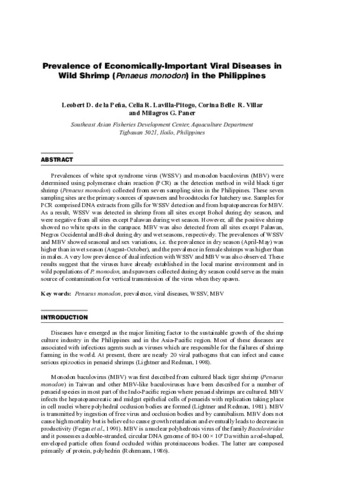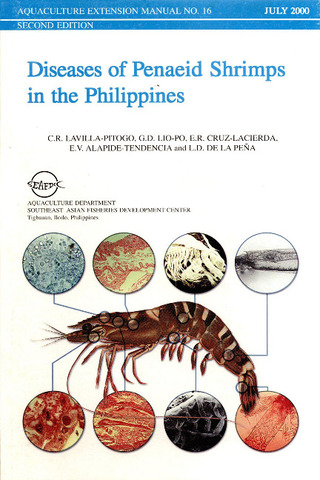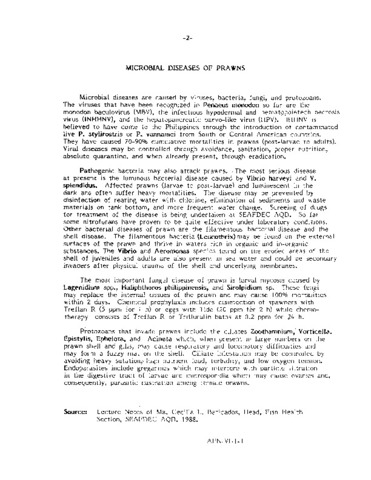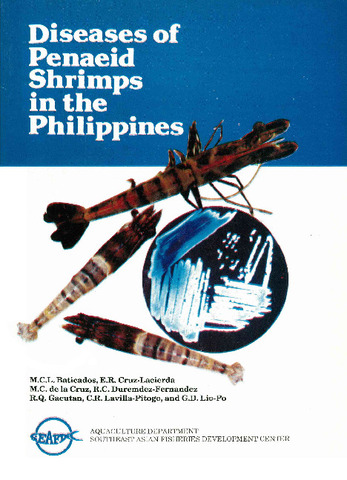Prevalence of economically-important viral diseases in wild shrimp (Penaeus monodon) in the Philippines
| dc.contributor.author | de la Peña, Leobert D. | |
| dc.contributor.author | Lavilla-Pitogo, Celia R. | |
| dc.contributor.author | Villar, Corina Belle R. | |
| dc.contributor.author | Paner, Milagros G. | |
| dc.contributor.editor | Nagasawa, Kazuya | |
| dc.date.accessioned | 2020-07-22T00:37:03Z | |
| dc.date.available | 2020-07-22T00:37:03Z | |
| dc.date.issued | 2005-03 | |
| dc.identifier.citation | de la Peña, L. D., Lavilla-Pitogo, C. R., Villar, C. B. R., & Paner, M. G. (2005). Prevalence of economically-important viral diseases in wild shrimp (Penaeus monodon) in the Philippines. In K. Nagasawa (Ed.), Recent Advances in Diagnosis and Prevention of Fish and Shrimp Diseases in Southeast Asia (pp. 105–114). Tigbauan, Iloilo, Philippines: Aquaculture Department, Southeast Asian Fisheries Development Center. | en |
| dc.identifier.isbn | 9718511732 | |
| dc.identifier.uri | http://hdl.handle.net/10862/5918 | |
| dc.description.abstract | Prevalences of white spot syndrome virus (WSSV) and monodon baculovirus (MBV) were determined using polymerase chain reaction (PCR) as the detection method in wild black tiger shrimp (Penaeus monodon) collected from seven sampling sites in the Philippines. These seven sampling sites are the primary sources of spawners and broodstocks for hatchery use. Samples for PCR comprised DNA extracts from gills for WSSV detection and from hepatopancreas for MBV. As a result, WSSV was detected in shrimp from all sites except Bohol during dry season, and were negative from all sites except Palawan during wet season. However, all the positive shrimp showed no white spots in the carapace. MBV was also detected from all sites except Palawan, Negros Occidental and Bohol during dry and wet seasons, respectively. The prevalences of WSSV and MBV showed seasonal and sex variations, i.e. the prevalence in dry season (April-May) was higher than in wet season (August-October), and the prevalence in female shrimps was higher than in males. A very low prevalence of dual infection with WSSV and MBV was also observed. These results suggest that the viruses have already established in the local marine environment and in wild populations of P. monodon, and spawners collected during dry season could serve as the main source of contamination for vertical transmission of the virus when they spawn. | en |
| dc.language.iso | en | en |
| dc.publisher | Aquaculture Department, Southeast Asian Fisheries Development Center | en |
| dc.subject | MBV | en |
| dc.subject | Penaeus monodon | en |
| dc.subject | Baculoviridae | en |
| dc.subject | Penaeus japonicus | en |
| dc.title | Prevalence of economically-important viral diseases in wild shrimp (Penaeus monodon) in the Philippines | en |
| dc.type | Book chapter | en |
| dc.citation.spage | 105 | en |
| dc.citation.epage | 114 | en |
| dc.citation.bookTitle | Recent Advances in Diagnosis and Prevention of Fish and Shrimp Diseases in Southeast Asia | en |
| dc.subject.asfa | White spot syndrome virus | en |
| dc.subject.asfa | viral diseases | en |
| dc.subject.asfa | animal diseases | en |
| dc.subject.asfa | polymerase chain reaction | en |
| dc.subject.asfa | DNA | en |
| dc.subject.asfa | nucleic acids | en |
| dc.subject.asfa | disease recognition | en |
| dc.subject.asfa | viruses | en |
| dc.subject.scientificName | Penaeus monodon | en |
Files in this item
This item appears in the following Collection(s)
-
Recent Advances in Diagnosis and Prevention of Fish and Shrimp Diseases in Southeast Asia [43]
Terminal Report of the Regional Fish Disease Project on “Development of Fish Disease Inspection Methodologies for Artificially-Bred Seeds” Funded by the Government of Japan Trust Fund from 2000 to 2004


 AQD Access only
AQD Access only



